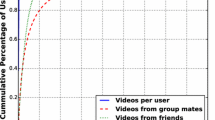Abstract
A great many tags and videos are shared and created by a mass of distributors on Web 2.0 video sharing sites. This increasing user-generated content can further benefit service innovation of collaborative tagging. In order to enhance efficient video retrieval and online video marketing (OVM) application, this research proposes a rank-mediated collaborative tagging recommendation service that allows the distributors predicting the ranks of video retrieval from the shared video archive using vote-promotion algorithm (VPA). The system experiments evaluate the number of tags and videos between simple text retrieval and VPA. The user surveys verify the relevance, helpfulness, and satisfaction of the recommended tags. From the perspectives of service innovation, this research is to develop a systematic and quantified a video-tag relationship prediction and recommendation self-service that can provide an intelligent collaborative tagging service on video sharing sites.










Similar content being viewed by others
References
2013 video share websites reviews, http://video-share-review.toptenreviews.com/.
Adam, R., Singurbjornsson, B., Zwol, R. V. (2010). Improving tag recommendation using social networks. Proceeding RIAO ’10 Adaptivity, Personalization and Fusion of Heterogeneous Information.
Bailey, J., Gruhl, D., Maglio, P., & Spohrer, J. (2007). Steps toward a science of service systems. IEEE Computer, 40(1), 1–77.
Bindelli, S., Criscione, C., Curino, C.A., Drago, M. L., Eynard, D., Orsi, G. (2008). Improving search and navigation by combining ontologies and social tags. On the move to meaningful internet systems (OTM-08), p. 76–86, LNCS 5333, Springer
Cantador, I., Vallet, D., Jose, J. M. (2008). Measuring vertex centrality in co-occurrence graphs for online social tag recommendation, ECML PKDD DC 2009, (pp.17–33).
Datta, R., Joshi, D., Li, J., Wang, J. Z. (2008). Image retrieval: Ideas, influences, and trends of the new age, ACM Computing Surveys.
Drucker, S., Edmunds, A., Morris, D., & White, R. (2007). Instrumenting the dynamic web. Journal of Web Engineering, 6(3), 244–260.
Gautam Das, M., & Hristidis, V. (2011). Leveraging collaborative tagging for web item design, KDD’11, August 21–24, 2011, San Diego, California, USA.
Golder, A. S., & Bernardo, A. (2006). Usage patterns of collaborative tagging systems. Journal of Information Science, 32(2), 198–208.
Jaschke, R., Marinho, L., Hotho, A., Schmidt-Thieme, L., Stumme, G. (2007). Tag recommendations in folksonomies, In proc. Of the European conference on Principles and Practice of Knowledge Discovery in Databases (pp.506–514).
Konstas, I., Stathopoulos, V., & Jose, J. M. (2009). On social networks and collaborative recommendation, In SIGIR ’09: Proceedings of the 32nd international ACM SIGIR conference on Research and development in information retrieval (pp.195–202).
Laurier, C., Sordo, M., Serra, J., Herrera, P. (2009). Music mood representation from social tags, in Proc. of the Intl. Society for Music Information Conf.
Leydesdorff, L., & Vaughan, L. (2006). Co-occurrence matrices and their applications in information science: Extending ACA to the Web environment. Journal of the American Society for Information Science and Technology, 57(12), 1616–1628.
Sanderson, M. & Zobel, J. (2005). Information retrieval system evaluation:effort, sensitivity, and reliability, In ACM SIGIR conference on Research and development in information retrieval (pp.162–169).
Singurbjornsson, B. & Zwol, R. V. (2008). Flickr tag recommendation based on collective knowledge, In WWW’08: Proceeding of the 17th International Conference on World Wide Web (pp.327–336).
Singurbjornsson. B. & Zwol, R. V. (2010). Improving tag recommendation using social networks. Proceeding RIAO ’10 Adaptivity, Personalization and Fusion of Heterogeneous Information.
Song, Y., Zhuang, Z., Li, H., Zhao, Q., Li, J., Lee, W.C., Giles, C.L. (2008). Real-time automatic tag recommendation, In SIGIR’08: Proceedings of the 31st annual international ACM SIGIR conference on Research and development in information retrieval (pp.515–522).
Suchanek, F., Vojnovic, M., Gunawardena, D. (2008). Social tags: Meaning and suggestions, In CIKM ’08, (pp.223–232).
Symeonidis, P., Ruxanda, M., Nanopoulos, A., Manolopoulos, Y. (2008). Ternary semantic analysis of social tags for personalized music recommendation. In Proceedings of ISMIR’08 (pp.219–224).
Vargo, S. L., Maglio, P. P., & Akaka, M. A. (2008). On value and value co-creation: A service systems and service logic perspective. Journal of European Management, 26, 145–152.
Wetzker, R., Said, A., Zimmermann, C. (2009). Understanding the user: Peronomy translation for tag recommendation. In ECML PKDD Discovery Challenge (pp. 275–285).
Author information
Authors and Affiliations
Corresponding author
Rights and permissions
About this article
Cite this article
Tung, WF., Lee, TY. Rank-mediated collaborative tagging recommendation service using video-tag relationship prediction. Inf Syst Front 15, 627–635 (2013). https://doi.org/10.1007/s10796-013-9436-7
Published:
Issue Date:
DOI: https://doi.org/10.1007/s10796-013-9436-7




